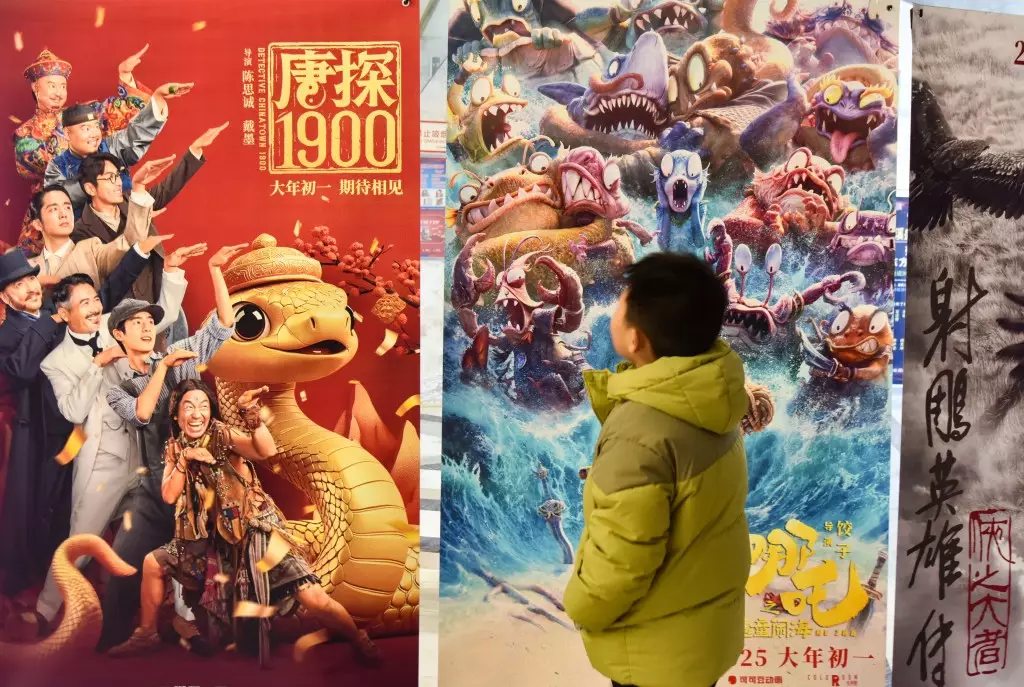As China transitions into the Year of the Snake, a notable cultural phenomenon unfolds within its cinema landscape. The Lunar New Year holiday, revered as a time of renewal and familial gatherings, coincides with the release of numerous domestic films that have captivated local audiences. Recent reports indicate an unprecedented surge in box office revenues, with total earnings between Wednesday and Sunday soaring to a staggering RMB 7 billion (approximately $965.4 million) according to Maoyan, a leading box office tracker. This year’s extended holiday, lasting until February 4, could potentially pave the way for an all-time record for the Lunar New Year period at the local box office.
This season has heralded remarkable achievements for Imax theaters in China, which reported cumulative earnings of $38.1 million from five newly released films. This performance not only surpassed the previous year’s figures of $34 million but also marked the largest box office gross during the Chinese New Year period for Imax. This illustrates a growing appetite for premium cinematic experiences among Chinese moviegoers, hinting at a broader trend towards high-quality content. The implications of this shift could redefine how films are marketed and consumed, especially during peak viewing periods like the Spring Festival.
In this flurry of cinematic releases, “Ne Zha 2,” an animated fantasy adventure that quickly climbed to the top of the box office charts, has emerged as a standout performer. Directed by Yu Yang, this sequel has amassed RMB 3.12 billion (around $430.3 million) by the end of the extended weekend, marking it as the frontrunner in the race for Lunar New Year box office supremacy. According to Maoyan’s predictions, “Ne Zha 2” is on track to gross an estimated $938 million, with analysts speculating it could very well be the first film to surpass the $1 billion mark in a single market.
Meanwhile, the “Detective Chinatown 1900” installment also held strong, occupying the second position with gross earnings of RMB 1.82 billion ($251 million). This film is part of a burgeoning franchise that, to date, has generated over $1.3 billion collectively. Notably, Imax reported earnings of $2.6 million from this title, further solidifying its status as a significant draw at the box office.
In addition to these blockbusters, other noteworthy titles have also made their mark. “Creation of the Gods II: Demon Force,” released by Alibaba, landed in third place with RMB 895.3 million ($123.5 million). This film illustrates the varied tastes of the audience and the rich storytelling present in modern Chinese cinema. Following closely was “Legend of the Condor Heroes: The Gallants,” a film steeped in cultural history and nostalgia, generating RMB 543.8 million ($75 million). Additionally, the latest entry in the beloved Boonie Bears franchise, “Boonie Bears: Future Reborn,” contributed RMB 418 million ($57.6 million) to the mix.
While these figures suggest widespread popularity, it’s crucial to acknowledge that the fiery momentum of this week does not necessarily indicate a complete recovery of the industry. The cinematic landscape in China experienced a downturn in 2024, with a decline in overall box office revenue by approximately 25% compared to the previous year.
A concerted effort on the part of the China Film Administration, which initiated a promotional scheme offering RMB 600 million ($83 million) to bolster ticket sales, underscores the industry’s commitment to rejuvenation. The Spring Festival is traditionally a crucial period for cinemas, and this initiative reflects a proactive approach to revitalizing audience engagement and enhancing the viewing experience.
As the lunar festivities continue, the promising figures and anticipation surrounding the films released during this period suggest a renewed vigor in the Chinese film industry. Furthermore, as audiences gather to celebrate and enjoy movies together during this festive season, the potential for lasting growth and revitalization appears more feasible than ever. All eyes will be on the evolving trends and audience preferences that will shape the future of Chinese cinema in the year ahead.
